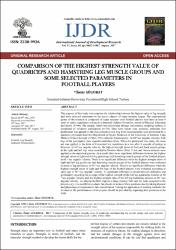| dc.contributor.author | Gülfırat, Ömür | |
| dc.date.accessioned | 2019-01-29T11:22:51Z | |
| dc.date.available | 2019-01-29T11:22:51Z | |
| dc.date.issued | 2017-08 | |
| dc.identifier.issn | 2230-9926 | |
| dc.identifier.uri | http://hdl.handle.net/11363/1047 | |
| dc.description.abstract | The purpose of this study is to examine the relationship between the highest value of leg strength and some selected parameters in the soccer players of super amateur league. The experimental group of the research is composed of super amateur level football players who have at least 4 years of sports experience and study at Istanbul Gelişim University, school of Physical Education and Sports (N=90). The sample, which was determined through convenience sampling method, is composed of voluntary participants (n=30). Data form (sport year, position, dominant foot preference) was applied as the data collection tool. Leg force measurements were performed by a specialist physician from the Department of Sports Medicine of the University of Istanbul, Çapa Medical School through a Cybex 350 Isokinetic dynamometer. At 60°/sec angular velocity, both legs of the participants were experimented three times. When the participant was ready, the same act was applied in the form of 4 maximal test repetitions in a row after 6 seconds of resting in between. At 60°/sec angular velocity, the highest strength ratios of front and back muscle groups at the right and left legs were recorded in Newton-Meter (Nm). T test and Anova analysis were applied as the statistical process. As a result, there is no significant difference between the highest strength ratios of right and left leg quadriceps and hamstring muscle groups of the football players at 60 °/sec angular velocity. There is no significant difference when the highest strength ratios of right and left leg quadriceps and hamstring muscle groups of the football players were evaluated in terms of leg preference at 60 °/sec angular velocity. There is no significant difference when the highest strength ratios of right and left legs of the football players were evaluated according to sport age at 60 °/sec angular velocity. A significant difference is found between defenders and goalkeepers regarding the average of the highest strength of the left leg quadriceps muscles at 60 °/sec angular velocity and the highest strength ratio of the left leg hamstring muscles at 60 °/sec angular velocity. As playing football requires a large playing field and the tasks assigned to the players vary, it is needful to evaluate the players in terms of their positions also by taking physical and physiological requirements into consideration. During the application of training methods; the increase in the performances of the players should be provided by regarding their positions in the field. | en_US |
| dc.language.iso | eng | en_US |
| dc.publisher | International Journal Development Research | en_US |
| dc.rights | info:eu-repo/semantics/openAccess | en_US |
| dc.rights | Attribution-NonCommercial-NoDerivs 3.0 United States | * |
| dc.rights.uri | http://creativecommons.org/licenses/by-nc-nd/3.0/us/ | * |
| dc.subject | Research Subject Categories::SOCIAL SCIENCES::Social sciences::Social work::Sports research | en_US |
| dc.title | Comparison of the Highest Strength Value of Quadriceps and Hamstring Leg Muscle Groups and Some Selected Parameters in Football Players | en_US |
| dc.type | article | en_US |
| dc.relation.ispartof | International Journal of Development Research | en_US |
| dc.department | İstanbul Gelişim Üniversitesi | en_US |
| dc.identifier.volume | 7 | en_US |
| dc.identifier.issue | 8 | en_US |
| dc.identifier.startpage | 14802 | en_US |
| dc.identifier.endpage | 14807 | en_US |
| dc.relation.publicationcategory | Kategori Yok | en_US |



















